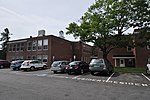Gilsland Farm
19th-century establishments in MaineBuildings and structures in Falmouth, MaineFarms in Cumberland County, MaineHouses completed in the 19th centuryHouses in Cumberland County, Maine ... and 1 more
Use mdy dates from June 2024
Gilsland Farm is a historic property in Falmouth, Maine, United States. In the early 19th century, Silas Noyes built a home on the land, formerly the home of the Wabanakis, a few yards from the eastern banks of the Presumpscot River. The home still stands today, now owned by Maine Audubon. It is known as the Gilsland Farm Audubon Center.
Excerpt from the Wikipedia article Gilsland Farm (License: CC BY-SA 3.0, Authors).Gilsland Farm
Gilsland Farm Road,
Geographical coordinates (GPS) Address Nearby Places Show on map
Geographical coordinates (GPS)
| Latitude | Longitude |
|---|---|
| N 43.70604 ° | E -70.24093 ° |
Address
Gilsland Farm Audubon Center Nature Store and Educational Center
Gilsland Farm Road
04105
Maine, United States
Open on Google Maps








